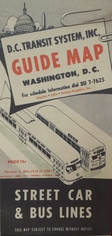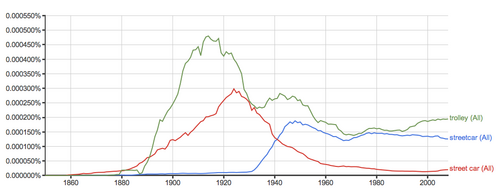“Streetcar” or “street car”? That is the question

The cover of a reproduction 1958 DC Transit map.
Soon (though we don’t know when), streetcars will start carrying passengers in DC after five decades in exile. That brings up an interesting question: How do we spell this new (yet old) technology?
In our comments, most of you write “streetcar” when talking about DDOT’s program to bring the railed vehicles back. But others among you say “street car” (with a space). Who’s right?
As it turns out, the answer is somewhat complicated. However, current usage favors the one-word version: “streetcar.” This is also the official name of the service in terms of DC’s branding.
But this hasn’t always been the case. When electric streetcars first came on the scene in the 1880s, they were often called “street cars.” Over time, this morphed into the one-word appellation. In the graph below, you can see the trend changed around 1940, with the contracted sobriquet catching on.
This graph, from Google’s ngram viewer, shows the count of the words “street car,” “streetcar,” and “trolley” in the corpus of American books (that Google has scanned).
According to the Oxford English Dictionary, the term in its modern usage dates back to at least 1839, when it was spelled “street-car.” At the time, it was being used to refer to horse cars, since the electric streetcar wasn’t around yet.
In examples from 1862, 1886, and 1929, the OED cites examples with “street car,” but examples from 1887 and 1967 use the consolidated “streetcar.” Prior to its modern usage, “street car” referred to a cart. In that context, the OED cites examples from 1671-1723.
Even after “streetcar” began to overtake “street car” as the preferred moniker, the two-word term persisted. And that was probably because streetcars were often called simply “cars.” This tradition continues today in San Francisco, where some streetcar and light rail stops are still called “car stops.” Often the only sign of transit stop is a swatch of yellow paint on the pavement with the stenciled words “car stop” or “bus stop.”
In the early days of bustitution, in fact, other terms started to emerge. To differentiate the new vehicles from streetcars, new labels were needed. Transit operators often referred to diesel or gasoline buses as “coaches” or “motor coaches.” Electric buses were “trolley buses” (sometimes one word) or “trackless trolleys.” Again, there are remnants. San Francisco still has “coach stops” scattered throughout the city.
On my reproduction 1958 DC Transit map, which would have been published less than four years before the end of streetcar service, streetcars are called “street cars” and the map shows “car and bus routes.”
You can also see in the legend a key to the numbering system, which persists today for Metrobus routes in DC, with rush hour routes using odd numbers and full-time routes using even numbers. Today’s numbered lines, like the 42, were streetcars, while letter-number lines, like the X2, were buses.
Clarification: The above paragraph is describing the legend on the 1958 map. In the past, there were streetcars operating on H Street. However, Capital Transit changed them from a number-number (e.g. 42) to a letter-number (e.g. X2) whenever they were bustituted. We apologize for any confusion the above paragraph may have caused.
Today, though, style guides and dictionaries have settled firmly on “streetcar” as the appropriate word. None of the transit services operating in North America use the two-word version in their branding, though “streetcar” isn’t universal; “trolley” still persists as the preferred term and brand in some cities.
A similar process appears to be happing with other words. We’re still settling on whether to call separated bike facilities “cycle tracks” or “cycletracks” (we’re calling them “protected bikeways”). Do you use “bike share” or “bikeshare?” The transition from “street car” to “streetcar” took a while, but these days it seems like the debate is over.


